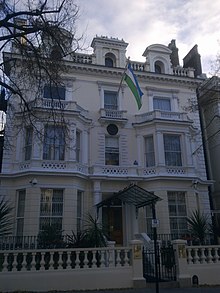4F2 세포표면 항원 헤비 체인
4F2 cell-surface antigen heavy chain| SLC3A2 | |||||||||||||||||||||||||
|---|---|---|---|---|---|---|---|---|---|---|---|---|---|---|---|---|---|---|---|---|---|---|---|---|---|
 | |||||||||||||||||||||||||
| |||||||||||||||||||||||||
| 식별자 | |||||||||||||||||||||||||
| 별칭 | SLC3A2, 4F2, 4F2HC, 4T2HC, CD98, CD98HC, MDU1, NACAE, 솔루트 캐리어 패밀리 3 멤버 2 | ||||||||||||||||||||||||
| 외부 ID | OMIM: 158070 MGI: 96955 HomoloGene: 1795 GeneCard: SLC3A2 | ||||||||||||||||||||||||
| |||||||||||||||||||||||||
| |||||||||||||||||||||||||
| |||||||||||||||||||||||||
| |||||||||||||||||||||||||
| 직교체 | |||||||||||||||||||||||||
| 종 | 인간 | 마우스 | |||||||||||||||||||||||
| 엔트레스 | |||||||||||||||||||||||||
| 앙상블 | |||||||||||||||||||||||||
| 유니프로트 | |||||||||||||||||||||||||
| RefSeq(mRNA) |
| ||||||||||||||||||||||||
| RefSeq(단백질) | |||||||||||||||||||||||||
| 위치(UCSC) | Chr 11: 62.86 – 62.89Mb | Cr 19: 8.68 – 8.7Mb | |||||||||||||||||||||||
| PubMed 검색 | [3] | [4] | |||||||||||||||||||||||
| 위키다타 | |||||||||||||||||||||||||
| |||||||||||||||||||||||||
4F2 세포표면 항원 헤비 체인은 인간에서 SLC3A2(솔루트 캐리어 패밀리 3 멤버 2) 유전자에 의해 암호화된 단백질이다.[5][6]
SLC3A2는 CD98(분화 98 클러스터)이라고도 하는 대형 중성 아미노산 트랜스포터(LAT1)의 중량 서브 유닛으로 구성된다.[7][8]
함수
SLC3A2는 솔루트 캐리어 계열의 일원으로, 알파-아밀라아제 영역으로 세포 표면, 트랜섬브레인 단백질을 인코딩한다.이 단백질은 이질화 결합을 통해 가능한 여러 개의 조명 체인 중 하나에 공칭으로 결합한 이질화체의 무거운 사슬로서 존재한다.그것은 정상 세포 성장 및 종양성장과 관련된 통합 의존적 신호와 연계하고 매개한다.다른 ISO 양식을 인코딩하는 대체 전사 스플라이스 변형이 특징지어졌다.[6]
LAT1은 중성지방(발렌, 류신, 이졸레우신)과 방향족(트립토판, 티로신, 페닐알라닌) 아미노산을 우선적으로 수송하는 이질성 막 운반 단백질이다.[9]LAT는 다른 조직에 비해 뇌 모세혈관(혈액 뇌 장벽을 형성함)에서 고도로 표현된다.[9]
기능성 LAT1 트랜스포터는 두 개의 뚜렷한 유전자에 의해 인코딩된 두 개의 단백질로 구성된다.
상호작용
SLC3A2는 SLC7A7과 상호작용하는 것으로 나타났다.[12]
또한 SLC3A2는 SLC7A11과 복합된 xc-시스틴/글루타마이트 항정신병 시스템의 구성 요소다.
참고 항목
참조
- ^ a b c GRCh38: 앙상블 릴리스 89: ENSG00000168003 - 앙상블, 2017년 5월
- ^ a b c GRCm38: 앙상블 릴리스 89: ENSMUSG000010095 - 앙상블, 2017년 5월
- ^ "Human PubMed Reference:". National Center for Biotechnology Information, U.S. National Library of Medicine.
- ^ "Mouse PubMed Reference:". National Center for Biotechnology Information, U.S. National Library of Medicine.
- ^ Teixeira S, Di Grandi S, Kühn LC (August 1987). "Primary structure of the human 4F2 antigen heavy chain predicts a transmembrane protein with a cytoplasmic NH2 terminus". J Biol Chem. 262 (20): 9574–80. doi:10.1016/S0021-9258(18)47972-0. PMID 3036867.
- ^ a b "Entrez Gene: SLC3A2 solute carrier family 3 (activators of dibasic and neutral amino acid transport), member 2".
- ^ Kucharzik T, Lugering A, Yan Y, Driss A, Charrier L, Sitaraman S, Merlin D (2005). "Activation of epithelial CD98 glycoprotein perpetuates colonic inflammation". Lab. Invest. 85 (7): 932–41. doi:10.1038/labinvest.3700289. PMID 15880135.
- ^ Lemaître G, Gonnet F, Vaigot P, Gidrol X, Martin MT, Tortajada J, Waksman G (2005). "CD98, a novel marker of transient amplifying human keratinocytes". Proteomics. 5 (14): 3637–45. doi:10.1002/pmic.200401224. PMID 16097038. S2CID 31954787.
- ^ a b Boado RJ, Li JY, Nagaya M, Zhang C, Pardridge WM (1999). "Selective expression of the large neutral amino acid transporter at the blood–brain barrier". Proc. Natl. Acad. Sci. U.S.A. 96 (21): 12079–84. Bibcode:1999PNAS...9612079B. doi:10.1073/pnas.96.21.12079. PMC 18415. PMID 10518579.
- ^ Palacín M, Kanai Y (2004). "The ancillary proteins of HATs: SLC3 family of amino acid transporters". Pflügers Arch. 447 (5): 490–494. doi:10.1007/s00424-003-1062-7. PMID 14770309. S2CID 25808108.
- ^ Verrey F, Closs EI, Wagner CA, Palacin M, Endou H, Kanai Y (2004). "CATs and HATs: the SLC7 family of amino acid transporters" (PDF). Pflügers Arch. 447 (5): 532–542. doi:10.1007/s00424-003-1086-z. PMID 14770310. S2CID 11670040.
- ^ Pfeiffer R, Rossier G, Spindler B, Meier C, Kühn L, Verrey F (January 1999). "Amino acid transport of y+L-type by heterodimers of 4F2hc/CD98 and members of the glycoprotein-associated amino acid transporter family". EMBO J. 18 (1): 49–57. doi:10.1093/emboj/18.1.49. PMC 1171101. PMID 9878049.
추가 읽기
- Rochelle JM, Watson ML, Oakey RJ, Seldin MF (1992). "A linkage map of mouse chromosome 19: definition of comparative mapping relationships with human chromosomes 10 and 11 including the MEN1 locus". Genomics. 14 (1): 26–31. doi:10.1016/S0888-7543(05)80278-2. PMID 1358795.
- Michalak M, Quackenbush EJ, Letarte M (1986). "Inhibition of Na+/Ca2+ exchanger activity in cardiac and skeletal muscle sarcolemmal vesicles by monoclonal antibody 44D7". J. Biol. Chem. 261 (1): 92–5. doi:10.1016/S0021-9258(17)42436-7. PMID 2416754.
- Gottesdiener KM, Karpinski BA, Lindsten T, Strominger JL, Jones NH, Thompson CB, Leiden JM (1989). "Isolation and structural characterization of the human 4F2 heavy-chain gene, an inducible gene involved in T-lymphocyte activation". Mol. Cell. Biol. 8 (9): 3809–19. doi:10.1128/mcb.8.9.3809. PMC 365439. PMID 3265470.
- Lindsten T, June CH, Thompson CB, Leiden JM (1989). "Regulation of 4F2 heavy-chain gene expression during normal human T-cell activation can be mediated by multiple distinct molecular mechanisms". Mol. Cell. Biol. 8 (9): 3820–6. doi:10.1128/mcb.8.9.3820. PMC 365440. PMID 3265471.
- Quackenbush E, Clabby M, Gottesdiener KM, Barbosa J, Jones NH, Strominger JL, Speck S, Leiden JM (1987). "Molecular cloning of complementary DNAs encoding the heavy chain of the human 4F2 cell-surface antigen: a type II membrane glycoprotein involved in normal and neoplastic cell growth". Proc. Natl. Acad. Sci. U.S.A. 84 (18): 6526–30. Bibcode:1987PNAS...84.6526Q. doi:10.1073/pnas.84.18.6526. PMC 299110. PMID 3476959.
- Lumadue JA, Glick AB, Ruddle FH (1988). "Cloning, sequence analysis, and expression of the large subunit of the human lymphocyte activation antigen 4F2". Proc. Natl. Acad. Sci. U.S.A. 84 (24): 9204–8. doi:10.1073/pnas.84.24.9204. PMC 299721. PMID 3480538.
- Posillico JT, Srikanta S, Eisenbarth G, Quaranta V, Kajiji S, Brown EM (1987). "Binding of monoclonal antibody (4F2) to its cell surface antigen on dispersed adenomatous parathyroid cells raises cytosolic calcium and inhibits parathyroid hormone secretion". J. Clin. Endocrinol. Metab. 64 (1): 43–50. doi:10.1210/jcem-64-1-43. PMID 3782435.
- Hemler ME, Strominger JL (1982). "Characterization of antigen recognized by the monoclonal antibody (4F2): different molecular forms on human T and B lymphoblastoid cell lines". J. Immunol. 129 (2): 623–8. PMID 6177771.
- Peters PG, Kamarck ME, Hemler ME, Strominger JL, Ruddle FH (1983). "Genetic and biochemical characterization of a human surface determinant on somatic cell hybrids: the 4F2 antigen". Somatic Cell Genet. 8 (6): 825–34. doi:10.1007/BF01543022. PMID 6187076. S2CID 19788137.
- Francke U, Foellmer BE, Haynes BF (1983). "Chromosome mapping of human cell surface molecules: monoclonal anti-human lymphocyte antibodies 4F2, A3D8, and A1G3 define antigens controlled by different regions of chromosome 11". Somatic Cell Genet. 9 (3): 333–44. doi:10.1007/BF01539142. PMID 6190235. S2CID 22972681.
- Haynes BF, Hemler ME, Mann DL, Eisenbarth GS, Shelhamer J, Mostowski HS, Thomas CA, Strominger JL, Fauci AS (1981). "Characterization of a monoclonal antibody (4F2) that binds to human monocytes and to a subset of activated lymphocytes". J. Immunol. 126 (4): 1409–14. PMID 7204970.
- Ohgimoto S, Tabata N, Suga S, Nishio M, Ohta H, Tsurudome M, Komada H, Kawano M, Watanabe N, Ito Y (1995). "Molecular characterization of fusion regulatory protein-1 (FRP-1) that induces multinucleated giant cell formation of monocytes and HIV gp160-mediated cell fusion. FRP-1 and 4F2/CD98 are identical molecules". J. Immunol. 155 (7): 3585–92. PMID 7561057.
- Maruyama K, Sugano S (1994). "Oligo-capping: a simple method to replace the cap structure of eukaryotic mRNAs with oligoribonucleotides". Gene. 138 (1–2): 171–4. doi:10.1016/0378-1119(94)90802-8. PMID 8125298.
- Andersson B, Wentland MA, Ricafrente JY, Liu W, Gibbs RA (1996). "A "double adaptor" method for improved shotgun library construction". Anal. Biochem. 236 (1): 107–13. doi:10.1006/abio.1996.0138. PMID 8619474.
- Ohgimoto S, Tabata N, Suga S, Tsurudome M, Kawano M, Nishio M, Okamoto K, Komada H, Watanabe N, Ito Y (1996). "Regulation of human immunodeficiency virus gp160-mediated cell fusion by antibodies against fusion regulatory protein 1". J. Gen. Virol. 77 (11): 2747–56. doi:10.1099/0022-1317-77-11-2747. PMID 8922468.
- Courseaux A, Grosgeorge J, Gaudray P, Pannett AA, Forbes SA, Williamson C, Bassett D, Thakker RV, Teh BT, Farnebo F, Shepherd J, Skogseid B, Larsson C, Giraud S, Zhang CX, Salandre J, Calender A (1997). "Definition of the minimal MEN1 candidate area based on a 5-Mb integrated map of proximal 11q13. The European Consortium on Men1, (GENEM 1; Groupe d'Etude des Néoplasies Endocriniennes Multiples de type 1)". Genomics. 37 (3): 354–65. doi:10.1006/geno.1996.0570. PMID 8938448.
- Yu W, Andersson B, Worley KC, Muzny DM, Ding Y, Liu W, Ricafrente JY, Wentland MA, Lennon G, Gibbs RA (1997). "Large-Scale Concatenation cDNA Sequencing". Genome Res. 7 (4): 353–8. doi:10.1101/gr.7.4.353. PMC 139146. PMID 9110174.
- Suzuki Y, Yoshitomo-Nakagawa K, Maruyama K, Suyama A, Sugano S (1997). "Construction and characterization of a full length-enriched and a 5'-end-enriched cDNA library". Gene. 200 (1–2): 149–56. doi:10.1016/S0378-1119(97)00411-3. PMID 9373149.
- Tabata N, Ido M, Suga S, Ohgimoto S, Tsurudome M, Kawano M, Nishio M, Watanabe N, Okamoto K, Komada H, Sakurai M, Ito Y (1998). "Protein tyrosine kinase activation provides an early and obligatory signal in anti-FRP-1/CD98/4F2 monoclonal antibody induced cell fusion mediated by HIV gp160". Med. Microbiol. Immunol. 186 (2–3): 115–23. doi:10.1007/s004300050053. PMID 9403839. S2CID 7693336.
외부 링크
- Large+Netric+Amino+Acid-Transporter+1(미국 국립 의학 라이브러리 의료 과목 제목)
- 아미노+아시드+미국 국립 의학 도서관(MesH)의 Transport+System+L(Transport+System+L)
이 기사는 공공영역에 있는 미국 국립 의학 도서관의 텍스트를 통합하고 있다.









